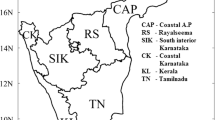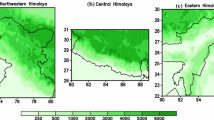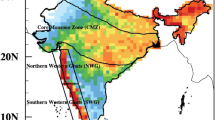Abstract
The current research aimed to evaluate the predictive skill of statistically downscaled National Aeronautics Space Administration (NASA) Earth Exchange Global Daily Downscaled Projection (NEX-GDDP) data in simulating the Indian summer monsoon rainfall (ISMR) for the period of 1961–2005 over the individual homogeneous monsoon regions of India (HMRI). For the purpose, five models are selected, as these models (in GCM) have shown better performance in the simulation of ISMR by the researcher. The spatial characteristics and statistical scores (annual cycle, percentage bias, Taylor score, probability distribution function) are used to evaluate the performance of each model in simulating rainfall over land points of individual HMRI. In the spatial analysis, it seems that models of NEX-GDDP can simulate the ISMR, pretty well in comparison to APHRODITE (observation), and show a moderate to significantly high correlation (grid point) over each of the HMRI particularly to core monsoon region, except over few parts of PI. The Taylor statistics suggest that the model CanESM performs very well over the regions of PI, NWI, and WCI. The models MPI-ESM-LR and NorESM perform well in simulating the ISMR over CNI, followed by ACCESS, CanESM, and CCSM4. The models have varying bias in predicting the rainfall; however, ACCESS does perform well and shows the minimum bias (ranges from ~ 1 to ~ 14% only) among others. The models CanESM and NorESM (except over CNI) performed relatively better. The NEX-GDDP models overcome the global climate models (GCMs) in the retrospective simulation of ISMR over the land points of India. It is concluded that the models have good predictability of JJAS rainfall but unable to catch daily rainfall variability.








Similar content being viewed by others
References
Bao Y, Wen X (2017) Projection of China’s near- and long-term climate in a new high-resolution daily downscaled dataset NEX-GDDP. J Meteorol Res 31:236–249. https://doi.org/10.1007/s13351-017-6106-6
Bokhari SAA, Ahmad B, Ali J, Ahmad S, Mushtaq H, Rasul G (2018) Future climate change projections of the Kabul River basin using a multi-model ensemble of high-resolution statistically downscaled data. Earth Syst Environ 2:477–497. https://doi.org/10.1007/s41748-018-0061-y
Chen H-P, Sun J-Q, Li H-X (2017) Future changes in precipitation extremes over China using the NEX-GDDP high-resolution daily downscaled data-set. Atmos Ocean Sci Lett 10:403–410. https://doi.org/10.1080/16742834.2017.1367625
Christensen JH, Christensen OB (2007) A summary of the PRUDENCE model projections of changes in European climate by the end of this century. Clim Chang 81:7–30
Christensen JH, Boberg F, Christensen OB, Lucas-Picher P (2008) On the need for bias correction of regional climate change projections of temperature and precipitation. Geophys Res Lett 35. https://doi.org/10.1029/2008GL035694
Durai VR, Bhardwaj R (2014) Forecasting quantitative rainfall over India using multi-model ensemble technique. Meteorog Atmos Phys 126:31–48. https://doi.org/10.1007/s00703-014-0334-4
Ekström M, Grose MR, Whetton PH (2015) An appraisal of downscaling methods used in climate change research. Wiley Interdiscip Rev Clim Chang 6:301–319
Errasti I, Ezcurra A, Sáenz J, Ibarra-Berastegi G (2011) Validation of IPCC AR4 models over the Iberian Peninsula. Theor Appl Climatol 103:61–79. https://doi.org/10.1007/s00704-010-0282-y
Fowler HJ, Blenkinsop S, Tebaldi C (2007) Linking climate change modelling to impacts studies: recent advances in downscaling techniques for hydrological modelling. Int J Climatol 27:1547–1578
Ghosh S, Vittal H, Sharma T, Karmakar S, Kasiviswanathan KS, Dhanesh Y, Sudheer KP, Gunthe SS (2016) Indian summer monsoon rainfall: implications of contrasting trends in the spatial variability of means and extremes. PLoS One 11:e0158670. https://doi.org/10.1371/journal.pone.0158670
Giorgi F (1990) Simulation of regional climate using a limited area model nested in a general circulation model. J Clim 3:941–963
Gregory S (1989) Macro-regional definition and characteristics of Indian summer monsoon rainfall, 1871--1985. Int J Climatol 9:465–483
Guhathakurta P, Rajeevan M (2008) Trends in the rainfall pattern over India. Int J Climatol 28:1453–1469
Hashmi MZ, Shamseldin AY, Melville BW (2011) Comparison of SDSM and LARS-WG for simulation and downscaling of extreme precipitation events in a watershed. Stoch Env Res Risk A 25:475–484
Huang J, Zhang J, Zhang Z et al (2011) Estimation of future precipitation change in the Yangtze River basin by using statistical downscaling method. Stoch Env Res Risk A 25:781–792
Mahmood R, Babel MS (2013) Evaluation of SDSM developed by annual and monthly sub-models for downscaling temperature and precipitation in the Jhelum basin, Pakistan and India. Theor Appl Climatol 113:27–44
Mandal V, De UK, Basu BK (2006) Verification of NCMRWF temperature output with observed data over West Bengal region during 2000-2002 monsoon period
Maraun D, Wetterhall F, Ireson AM et al (2010) Precipitation downscaling under climate change: recent developments to bridge the gap between dynamical models and the end user. Rev Geophys 48
Maurer EP, Hidalgo HG (2008) Utility of daily vs. monthly large-scale climate data: an intercomparison of two statistical downscaling methods
McSweeney CF, Jones RG, Lee RW, Rowell DP (2015) Selecting CMIP5 GCMs for downscaling over multiple regions. Clim Dyn 44:3237–3260. https://doi.org/10.1007/s00382-014-2418-8
Mearns LO, Bogardi I, Giorgi F et al (1999) Comparison of climate change scenarios generated from regional climate model experiments and statistical downscaling. J Geophys Res Atmos 104:6603–6621
Meher JK, Das L, Akhter J et al (2017) Performance of CMIP3 and CMIP5 GCMs to simulate observed rainfall characteristics over the Western Himalayan region. J Clim 30:7777–7799
Parthasarathy B (1984) Interannual and long-term variability of Indian summer monsoon rainfall. Proc Indian Acad Sci Planet Sci 93:371–385
Parthasarathy B, Kumar KR, Munot AA (1993) Homogeneous Indian monsoon rainfall - variability and prediction. Proc Indian Acad Sci Planet Sci 102:121–155
Pattanaik DR, Kumar A (2010) Prediction of summer monsoon rainfall over India using the NCEP climate forecast system. Clim Dyn 34:557–572. https://doi.org/10.1007/s00382-009-0648-y
Pepler AS, Alexander LV, Evans JP, Sherwood SC (2016) Zonal winds and southeast Australian rainfall in global and regional climate models. Clim Dyn 46:123–133. https://doi.org/10.1007/s00382-015-2573-6
Raghavan SV, Hur J, Liong SY (2018) Evaluations of NASA NEX-GDDP data over Southeast Asia: present and future climates. Clim Chang 148:503–518. https://doi.org/10.1007/s10584-018-2213-3
Rajeevan M, Bhate J, Kale JD, Lal B (2006) High resolution daily gridded rainfall data for the Indian region: analysis of break and active monsoon spells. Curr Sci 91:296–306
Rana A, Uvo CB, Bengtsson L, Sarthi PP (2012) Trend analysis for rainfall in Delhi and Mumbai, India. Clim Dyn 38:45–56. https://doi.org/10.1007/s00382-011-1083-4
Reichler T, Kim J (2008) How well do coupled models simulate today’s climate? Bull Am Meteorol Soc 89:303–311. https://doi.org/10.1175/BAMS-89-3-303
Rivington M, Miller D, Matthews KB et al (2008) Downscaling regional climate model estimates of daily precipitation, temperature and solar radiation data. Clim Res 35:181–202
Sagar SK, Mrudula G, Kumari KV, Rao SVB (2017) Verification of Varsha rainfall forecasts for summer monsoon seasons of 2009 and 2010. Int J Cur Res Rev| Vol 9:24
Saha A, Ghosh S, Sahana AS, Rao EP (2014) Failure of CMIP5 climate models in simulating post-1950 decreasing trend of Indian monsoon. Geophys Res Lett 41:7323–7330. https://doi.org/10.1002/2014GL061573
Sahany S, Mishra SK, Salunke P (2019) Historical simulations and climate change projections over India by NCAR CCSM4: CMIP5 vs. NEX-GDDP. Theor Appl Climatol 135:1423–1433
Saini R, Wang G, Yu M, Kim J (2015) Comparison of RCM and GCM projections of boreal summer precipitation over Africa. J Geophys Res Atmos 120:3679–3699
Sarthi PP, Ghosh S, Kumar P (2015) Possible future projection of Indian summer monsoon rainfall (ISMR) with the evaluation of model performance in coupled model inter-comparison project phase 5 (CMIP5). Glob Planet Chang 129:92–106
Sarthi PP, Kumar P, Ghosh S (2016) Possible future rainfall over Gangetic Plains (GP), India, in multi-model simulations of CMIP3 and CMIP5. Theor Appl Climatol 124:691–701
Shukla J (1987) Interannual variability of monsoons. Monsoons:399–464
Sinha A, Cannariato KG, Stott LD et al (2007) A 900-year (600 to 1500 A.D.) record of the Indian summer monsoon precipitation from the core monsoon zone of India. Geophys Res Lett 34:1–5. https://doi.org/10.1029/2007GL030431
Solomon S, Qin D, Manning M et al (2007) Climate change 2007-the physical science basis: working group I contribution to the fourth assessment report of the IPCC. Cambridge university press
Sonali P, Kumar DN, Nanjundiah RS (2017) Intercomparison of CMIP5 and CMIP3 simulations of the 20th century maximum and minimum temperatures over India and detection of climatic trends. 465–489. https://doi.org/10.1007/s00704-015-1716-3
Sun J, Chen H (2012) A statistical downscaling scheme to improve global precipitation forecasting. Meteorog Atmos Phys 117:87–102. https://doi.org/10.1007/s00703-012-0195-7
Sunyer MA, Madsen H, Ang PH (2012) A comparison of different regional climate models and statistical downscaling methods for extreme rainfall estimation under climate change. Atmos Res 103:119–128
Taylor KE (2001) Summarizing multiple aspects of model performance in a single diagram. J Geophys Res Atmos 106:7183–7192
Taylor KE, Stouffer RJ, Meehl GA (2012) An overview of CMIP5 and the experiment design. Bull Am Meteorol Soc 93:485–498. https://doi.org/10.1175/BAMS-D-11-00094.1
Thrasher B, Maurer EP, Duffy PB, McKellar C (2012a) Bias correcting climate model simulated daily temperature extremes with quantile mapping
Thrasher B, Maurer EP, McKellar C, Duffy PB (2012b) Technical note: bias correcting climate model simulated daily temperature extremes with quantile mapping. Hydrol Earth Syst Sci 16:3309–3314. https://doi.org/10.5194/hess-16-3309-2012
Thrasher B, Xiong J, Wang W et al (2013) Downscaled climate projections suitable for resource management. EOS Trans Am Geophys Union 94:321–323
Trzaska S, Schnarr E (2014) A review of downscaling methods for climate change projections. United States Agency Int Dev by Tetra Tech ARD 1–42
Turner AG, Annamalai H (2012) Climate change and the South Asian summer monsoon. Nat Clim Chang 2:587–595. https://doi.org/10.1038/nclimate1495
Walker GT (1925) Correlation in seasonal variations of weather—a further study of world weather. Mon Weather Rev 53:252–254
Wilby RL, Wigley TML (1998) Downscaling general circulation model output: a review of methods and limitations. Prog Phys Geogr 21:530–548
Wilby RL, Wigley TML, Conway D, et al (1998) Statistical downscaling of general circulation model output: A comparison of methods. Water Resour Res 34:2995–3008. https://doi.org/10.1029/98WR02577
Wilby RL, Dawson CW, Barrow EM (2002) SDSM — a decision support tool for the assessment of regional climate change impacts. Environ Model Softw 17:145–157. https://doi.org/10.1016/S1364-8152(01)00060-3
Wood AW, Maurer EP, Kumar A, Lettenmaier DP (2002) Long-range experimental hydrologic forecasting for the eastern United States. J Geophys Res D Atmos 107:1–15. https://doi.org/10.1029/2001JD000659
Wood AW, Leung LR, Sridhar V, Lettenmaier DP (2004) Hydrologic implications of dynamical and statistical approaches to downscaling climate model outputs. Clim Chang 62:189–216
Xie SP, Xu H, Saji NH et al (2006) Role of narrow mountains in large-scale organization of Asian monsoon convection. J Clim 19:3420–3429. https://doi.org/10.1175/JCLI3777.1
Yatagai A, Kamiguchi K, Arakawa O et al (2012) Aphrodite constructing a long-term daily gridded precipitation dataset for Asia based on a dense network of rain gauges. Bull Am Meteorol Soc 93:1401–1415. https://doi.org/10.1175/BAMS-D-11-00122.1
Zamani R, Berndtsson R (2018) Evaluation of CMIP5 models for west and Southwest Iran using TOPSIS-based method. Theor Appl Climatol 137:533–543. https://doi.org/10.1007/s00704-018-2616-0
Acknowledgments
Climate scenarios used were from the NEX-GDDP dataset, prepared by the Climate Analytics Group and NASA Ames Research Center using the NASA Earth Exchange, and distributed by the NASA Center for Climate Simulation (NCCS).
Author information
Authors and Affiliations
Corresponding author
Additional information
Publisher’s note
Springer Nature remains neutral with regard to jurisdictional claims in published maps and institutional affiliations.
Rights and permissions
About this article
Cite this article
Kumar, P., Kumar, S., Barat, A. et al. Evaluation of NASA’s NEX-GDDP-simulated summer monsoon rainfall over homogeneous monsoon regions of India. Theor Appl Climatol 141, 525–536 (2020). https://doi.org/10.1007/s00704-020-03188-2
Received:
Accepted:
Published:
Issue Date:
DOI: https://doi.org/10.1007/s00704-020-03188-2




